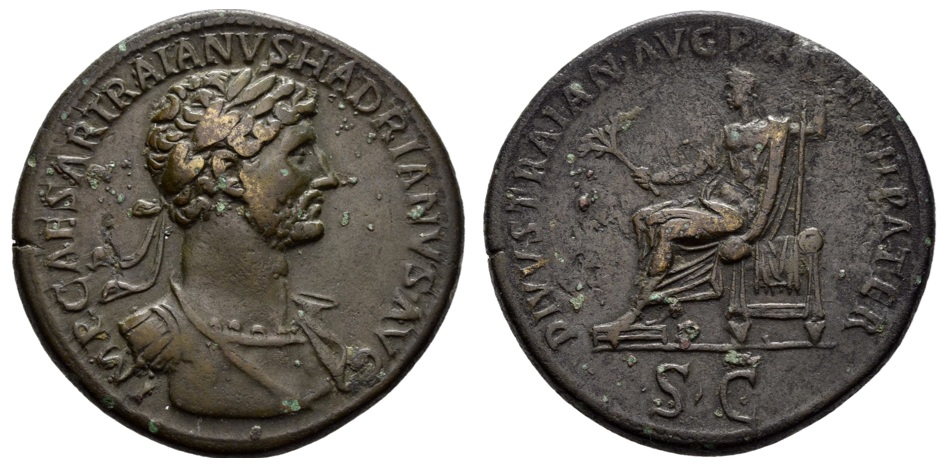Rome (Hadrian), bronze, sestertii (Hadrian/seated Trajan) (117-118 CE)
From SILVER
(Redirected from S 1560 - Rome (Trajan), bronze, sestertii (117-118 CE))
117 CE - 118 CE Bronze
Description
| ObverseInscription or printing placed on the obverse.: | IMP CAESAR TRAIANVS AVG (Latin).Laurate bust of Hadrian r. |
| ReverseInscription or printing placed on the reverse.: | DIVVS TRAIAN AVG PARTH PATER (Latin).Divine Trajan seated l. |
Mint and issuing power
| MintIdentifies the place of manufacture or issue of a numismatic object.: | Rome | Ancient regionAncient region.: | Latium | Modern countryModern country: Italy | AuthorityIdentifies the issuing power. The authority can be "pretended" when the name or the portrait of X is on the coin but he/she was not the issuing power. It can also be "uncertain" when there is no mention of X on the coin but he/she was the issuing power according to the historical sources: | Roman Empire, Trajan (Roman emperor, 98-117 AD), Hadrian (Roman emperor, 117-138 AD) |
Chronology
| FromIdentifies the initial date in a range assigned in a numismatic context. | 117 CE | toIdentifies the final date in a range assigned in a numismatic context.. | 118 CE | PeriodTime period of the numismatic object.: Roman from 30 BC |
Physical description
| MetalThe physical material (usually metal) from which an object is made.: | Bronze |
Median weightMedian of the weights of numismatic objects (in grams). in grams | 26.00 | DenominationTerm indicating the value of a numismatic object. Examples: tetradrachm, chalkous, denarius.: | sestertius | StandardStandard.: |
Image

Rome_RIC_II_104_105.jpg [1]
References
| Die study referencePublication of the study: | Woytek 20221Woytek 2022 | ||
| Coin series referenceReference to coin series study: | RIC II.32RIC II.3, n° 104-105 | ||
| Coin series web referenceCoin series web references: | |||
Obverse dies distribution
| FrequencyFrequency of specimen in distribution. ᵖ | Number of obversesNumber of obverse dies. ᵖ (o) | % (o) | Number of coinsNumber of coins. (n) | % (n) | Die nameName(s) of the die(s). |
| 1 | 4 | 66.67 | 4 | 50 | 2, 4, 5, 6 |
| 2 | 2 | 33.33 | 4 | 50 | 1, 3 |
| Total | 6 of 6 | 100 | 8 of 8 | 100 |
Reverse dies distribution
no distribution is available
Quantification
| Number of obversesNumber of obverse dies. ᵖ (o) | 6 | Number of singletons (o1)The number of singleton coins. ᵖ | 4 |
| Number of reverse diesNumber of reverse dies. (r) | Number of coinsNumber of coins. (n) | 8 | |
| Coins per obverse dieNumber of coins per obverse die. (n/o) | 1.33 | Coins per reverse dieNumber of coins per reverse die. (n/r) | |
| Reverse per obverse ratioRatio of obverse dies divided by reverse dies. (r/o) | Percentage of singletons (o1)number of coins (n) divided by the number of singletons (o1) ᵖ | 66.67 % | |
| Original number of dies (O) (Carter 1983 formula)The estimation of the number of coins according to Carter 1983 ᵖ | 18.97 | Coins struck if 20,000 as average productivity per dieCoins made if the average productivity for obverses (according to Carter) is 20,000. ᵖ | 379,400 |
| Original number of dies (O) (Esty 2011 formula)The estimation of the number of coins according to the singleton formula in Esty 2011 ᵖ (O) | 24 | Survival rate if 20,000 as average productivity per dieSurvival rate if average productivity is 20,000. ᵖ | 0.00002 |
| Coverage (o = % of O) (Esty 1984 formula)Esty 1984 - coverage (% of O) ᵖ (o = % of O) | 50% | Die productivity if survival rate 1/2,000Average productivity if survival rate is 1/2,000. ᵖ | 843.44 |
| Weight of silver (in kg) if 20,000 coins per die (O = Carter formula)Carter 1983 * Median weight * 20000 (*10 if gold or electrum) ᵖ | n.a. | Die productivity if survival rate 1/5,000Average productivity if survival rate is 1/5,000. ᵖ | 2,108.59 |
Remarks